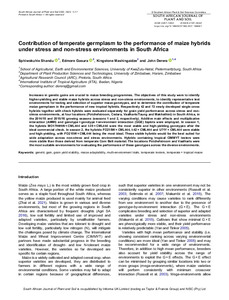| dc.contributor.author | Shandu, S.F. |
| dc.contributor.author | Gasura, E. |
| dc.contributor.author | Mashingaidze, K. |
| dc.contributor.author | Derera, J. |
| dc.date.accessioned | 2022-06-08T09:01:49Z |
| dc.date.available | 2022-06-08T09:01:49Z |
| dc.date.issued | 2022 |
| dc.identifier.citation | Shandu, S.F., Gasura, E., Mashingaidze, K. & Derera, J. (2022). Contribution of temperate germplasm to the performance of maize hybrids under stress and non-stress environments in South Africa. South African Journal of Plant and Soil, 39(1), 1-11. |
| dc.identifier.issn | 0257-1862 |
| dc.identifier.uri | https://hdl.handle.net/20.500.12478/7495 |
| dc.description.abstract | Increases in genetic gains are crucial to maize breeding programmes. The objectives of this study were to identify higher-yielding and stable maize hybrids across stress and non-stress environments, to identify representative test environments for testing and selection of superior maize genotypes, and to determine the contribution of temperate maize germplasm in the performance of new tropical hybrids. Respectively 42 and 72 newly developed single-cross hybrids together with check hybrids were evaluated separately for grain yield performance across stress and non-stress environments, at four locations (Potchefstroom, Cedara, Vaalharts/Taung and Makhathini) in South Africa, in the 2014/15 and 2015/16 growing seasons (seasons 1 and 2, respectively). Additive main effects and multiplicative interaction (AMMI) and genotype + genotype × environment interaction (GGE) biplots were employed. In season 1, the hybrids MO17HtHtN × CML444 and I-39 × CML444 were the most stable and high-yielding genotypes after the ideal commercial check. In season 2, the hybrids FO215W × CML444, I-42 × CML444 and U71Y × CML444 were stable and high-yielding, with FO215W × CML444 being the most ideal. These stable hybrids would be the best suited for wide adaptation across non-stress and stress environments. Hybrids containing tropical CIMMYT testers were more stable than those derived from temperate Corn Belt material. The locations Potchefstroom and Vaalharts were the most suitable environments for evaluating the performance of these genotypes across the diverse environments. |
| dc.format.extent | 1-11 |
| dc.language.iso | en |
| dc.subject | Genetic Gain |
| dc.subject | Grain |
| dc.subject | Yields |
| dc.subject | Maize |
| dc.subject | Hybrids |
| dc.subject | Genotypes |
| dc.subject | Genotype Environment Interaction |
| dc.title | Contribution of temperate germplasm to the performance of maize hybrids under stress and non-stress environments in South Africa |
| dc.type | Journal Article |
| cg.contributor.affiliation | University of KwaZulu-Natal |
| cg.contributor.affiliation | University of Zimbabwe |
| cg.contributor.affiliation | Agricultural Research Council, South Africa |
| cg.contributor.affiliation | International Institute of Tropical Agriculture |
| cg.coverage.region | Africa |
| cg.coverage.region | Southern Africa |
| cg.coverage.country | South Africa |
| cg.coverage.hub | Headquarters and Western Africa Hub |
| cg.identifier.bibtexciteid | SHANDU:2022 |
| cg.isijournal | ISI Journal |
| cg.authorship.types | CGIAR and developing country institute |
| cg.iitasubject | Agronomy |
| cg.iitasubject | Climate Change |
| cg.iitasubject | Food Security |
| cg.iitasubject | Maize |
| cg.iitasubject | Plant Breeding |
| cg.iitasubject | Plant Genetic Resources |
| cg.iitasubject | Plant Production |
| cg.iitasubject | Smallholder Farmers |
| cg.journal | South African Journal of Plant and Soil |
| cg.notes | Published online: 16 May 2022 |
| cg.accessibilitystatus | Limited Access |
| cg.reviewstatus | Peer Review |
| cg.usagerightslicense | Copyrighted; all rights reserved |
| cg.targetaudience | Scientists |
| cg.identifier.doi | https://dx.doi.org/10.1080/02571862.2021.1994047 |
| cg.iitaauthor.identifier | John Derera: 0000-0003-3715-0689 |
| cg.futureupdate.required | No |
| cg.identifier.issue | 1 |
| cg.identifier.volume | 39 |

